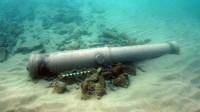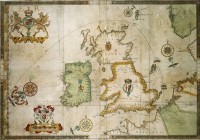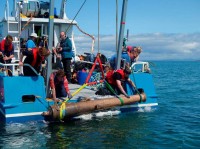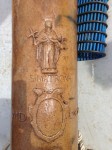 This April, the remains of a shipwreck began washing up on the long sandy beach of Streedagh Strand in County Sligo on the west coast of Ireland. A man walking along the beach found a weathered piece of wood and alerted authorities who identified it as the rudder from one of three ships from the Spanish Armada known to have wrecked off the Streedagh coast on September 21st, 1588. The wrecks were discovered in 15 to 30 feet of water in 1985 and have remained untouched, protected by layers of sand, on the seabed ever since. Severe winter storms over the past two years are believed to have dislodged some of the looser objects from the wrecks while the remains of the ships themselves are still safe under their cover of sand.
This April, the remains of a shipwreck began washing up on the long sandy beach of Streedagh Strand in County Sligo on the west coast of Ireland. A man walking along the beach found a weathered piece of wood and alerted authorities who identified it as the rudder from one of three ships from the Spanish Armada known to have wrecked off the Streedagh coast on September 21st, 1588. The wrecks were discovered in 15 to 30 feet of water in 1985 and have remained untouched, protected by layers of sand, on the seabed ever since. Severe winter storms over the past two years are believed to have dislodged some of the looser objects from the wrecks while the remains of the ships themselves are still safe under their cover of sand.
To ensure the artifacts would not be looted or washed out to sea, Ireland’s Department for Arts, Heritage and the Gaeltacht sent a team of divers to recover them from the seabed. Recovery operations ended last week and they were remarkably successful. Divers retrieved nine bronze cannons, a gun carriage wheel, cannon balls, a ship’s cauldron and numerous smaller objects. The artifacts appear to be in excellent condition and will be conserved by experts at the National Museum of Ireland for future display. The conservation process will take at least two years, however, so they won’t be on public view for a long time.
 The coast of Ireland is something of a graveyard for the soldiers and sailors of the Spanish Armada. When King Philip II’s purportedly invincible fleet of 130 heavily armed ships was defeated by the English navy and its deadly fireships, the Armada fled north, sailing around the coast of Scotland and over to western Ireland into the North Atlantic where it was welcomed by a particularly brutal storm season. As many ships had had to cut away their anchors in their hasty flight from the English fireships in Calais, they were unable to drop anchor somewhere protected and weather out the storm. An estimated 5,000 men of the Spanish Armada died from drowning, starvation, disease and execution by English soldiers in Scotland and Ireland.
The coast of Ireland is something of a graveyard for the soldiers and sailors of the Spanish Armada. When King Philip II’s purportedly invincible fleet of 130 heavily armed ships was defeated by the English navy and its deadly fireships, the Armada fled north, sailing around the coast of Scotland and over to western Ireland into the North Atlantic where it was welcomed by a particularly brutal storm season. As many ships had had to cut away their anchors in their hasty flight from the English fireships in Calais, they were unable to drop anchor somewhere protected and weather out the storm. An estimated 5,000 men of the Spanish Armada died from drowning, starvation, disease and execution by English soldiers in Scotland and Ireland.
Around 1,000 sailors and soldiers were aboard the three ships that fell victim to one of those North Atlantic storms off of Streedagh. They were hugging the coast, trying to avoid the worst of the Atlantic storm, but the storm won, battering the ships so viciously that within an hour all three had sunk. Out of the 1,000 soldiers and crew, 140 men made it to shore only to be killed by the English garrison at Sligo. Others were killed by Only a handful of men managed to make it out alive, protected by local Irish chieftains who, although threatened by the English authorities with execution should they attempt to lend succor to any Spanish survivors, were more than glad to risk their lives to stick it to the hated (Protestant) English by supporting their (Catholic) enemies.
 One of those survivors, Franciso de Cuellar, captain of the 24-gun galleon San Pedro, wrote of his experience in a letter, a remarkable testimony that has thankfully survived for our edification. A quick bit of context: he writes in the beginning of the letter of being condemned to death unjustly. That’s because he was accused of disobedience when the San Pedro broke from the rest of the fleet in the North Atlantic to get some sleep and repair his ship, was sentenced to die and transferred to the galleon San Juan de Sicilia for execution. They never got around to killing him before the storm cast him ashore at Streedagh with 300 other Armada survivors, most of whom were not survivors for long. With all his talk of savages (the native Irish) and misadventure after misadventure, it reads like something from Gulliver’s Travels.
One of those survivors, Franciso de Cuellar, captain of the 24-gun galleon San Pedro, wrote of his experience in a letter, a remarkable testimony that has thankfully survived for our edification. A quick bit of context: he writes in the beginning of the letter of being condemned to death unjustly. That’s because he was accused of disobedience when the San Pedro broke from the rest of the fleet in the North Atlantic to get some sleep and repair his ship, was sentenced to die and transferred to the galleon San Juan de Sicilia for execution. They never got around to killing him before the storm cast him ashore at Streedagh with 300 other Armada survivors, most of whom were not survivors for long. With all his talk of savages (the native Irish) and misadventure after misadventure, it reads like something from Gulliver’s Travels.
The enemies and savages, who were on the beach stripping those who had been able to reach it by swimming, did not touch me nor approach me, seeing me, as I have said, with my legs and hands and my linen trousers covered with blood. In this condition I proceeded, little by little, as I could, meeting many Spaniards stripped to the skin, without any kind of clothing whatsoever upon them, chattering with the cold, which was severe, and thus I stopped for the night in a deserted place, and was forced to lie down upon some rushes on the ground, with the great pain I suffered in my leg. Presently a gentleman came up to me, a very nice young fellow, quite naked, and he was so dazed that he could not speak, not even to tell me who he was; and at that time, which would be about nine o’clock at night, the wind was calm and the sea subsiding.
His silent companion died soon thereafter, but Cuellar, thanks to the help of “savages” and Irish lord Sir Brian O’Rourke of Leitrim who would in 1591 be executed for lending aid to Spanish Armada refugees, eventually made it to Scotland and thence to Flanders and home. Not before surviving one more shipwreck, though, when his vessel was attacked by the Dutch off the coast of Dunkirk.

 Two of the Streedagh shipwrecks were identified in the 80s as the 25-gun La Lavia and the 18-gun Santa Maria De Vison, and the third was thought to be merchant vessel La Juliana commandeered by King Philip II for his fleet and outfitted as a 32-gun warship, but there was some question that it might be Cuellar’s galleon the San Pedro. The recently recovered artifacts prove that it is indeed what remains of La Juliana. One cannon in particular is the smoking gun, so to speak. The bronze cannon is decorated with the image of Saint Matrona of Barcelona, a saint venerated in Barcelona and in other towns of Catalonia, and is stamped with a date of 1570. La Juliana was built near Barcelona in 1570.
Two of the Streedagh shipwrecks were identified in the 80s as the 25-gun La Lavia and the 18-gun Santa Maria De Vison, and the third was thought to be merchant vessel La Juliana commandeered by King Philip II for his fleet and outfitted as a 32-gun warship, but there was some question that it might be Cuellar’s galleon the San Pedro. The recently recovered artifacts prove that it is indeed what remains of La Juliana. One cannon in particular is the smoking gun, so to speak. The bronze cannon is decorated with the image of Saint Matrona of Barcelona, a saint venerated in Barcelona and in other towns of Catalonia, and is stamped with a date of 1570. La Juliana was built near Barcelona in 1570.